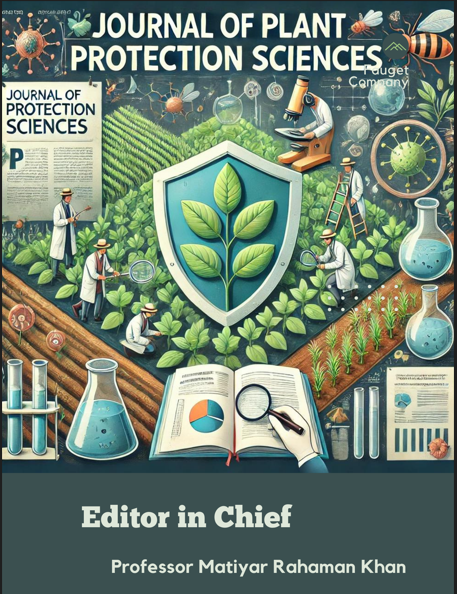Management of root holoparasite Aeginetia pedunculata of (Orobanchaceae), causing wilt of sugarcane by trap and catch crops
DOI:
https://doi.org/10.48165/Keywords:
Holoparasitic angiosperm, Orobanchaceae, Aeginetia pedunculata, integrated management, trap crop, catch crop, seed viability, germination, soil seed bank, Sugarcane (Saccharum spp.)Abstract
Sugarcane wilt caused by Aeginetia pedunculata (Roxb.) Wall. (Orobanchaceae) is endemic in the command area of Plassey Sugar Mill in the districts of Nadia and Murshidabad in West Bengal. It spreads through water-and soil-borne seeds. With the objective of developing location-specific integrated management schedule of the parasite, crops, other than sugarcane, grown in the target area were evaluated for their potential as trap and catch crops of the parasite. Twelve crops, selected on the basis of germination induction test of A. pedunculata seeds on root exudates as compared to that of three germination inducing chemicals (viz.; NaOCl, TTC (2,3,5-triphenyl tetrazolium chloride) and GR24-a strigol analogue) and growth of the parasite on excised root pieces of prevalent crop cultivars including sugarcane, were evaluated in A. pedunculata infested sugarcane field for their (crops) efficacy to deplete or recharge the parasite seeds in soil. Rice (Oryza sativa L.), maize (Zea mays L.), pearl millet (Pennisetum typhoides Staph. & Hubbard.), italian millet (Setaria italica (L.) Breauv.), black gram (Phaseolus mungo L.), dhaincha (Sesbania aculeata (Willd.) Pers.), sesame (Sesamum indicum L.), jute (Corchorus olitorius L.), pigeon pea (Cajanus cajan (L.) Millsp.), and groundnut (Arachis hypogaea L.) were found effective as trap crops for their ability to germinate the seed of A. pedunculata. Sorghum (Sorghum bicolor (L.) Moench) was identified as a catch crop for its ability to support further growth and development of A. pedunculata up to flowering.
References
Aeginetia indica L. (I. General Survey). Botanical Magazine, Tokyo, 96(1043), 203-209.
Botanga, C.J., Alabi, S.O., Echekwu, C.A., & Lagoke, S.T.O. (2003). Genetics of suicidal germination of Striga hermonthica (Del.) Benth. by cotton. Crop Science, 43, 483-488.
Carsky, R.J., Berner, D.K., Oyewole, B.D., Dashiell, K., & Schulz, S. (2000). Reduction of Striga hermonthica parasitism on maize using soybean rotation. International Journal of Pest Management, 46(2), 115-120.
Carsky, R.J., Singh, L., & Ndikawa, R. (1994). Suppression of Striga hermonthica on sorghum using a cowpea intercrop. Experimental Agriculture, 30, 349-358.
Espino, R.B. (1947). Eleven years study on "bungang tubo": A resume. Philippine Agriculturist, 31, 151-153.
French, R.C. & Sherman, L.J. (1976). Factors affecting dormancy, germination and seedling development of Aeginetia indica L. (Orobanchaceae). American Journal of Botany, 63(5), 558-570.
Gworgwor, N.A. (2000). Effect of intercropping sorghum with groundnut on Striga hermonthica on sorghum in the semi-arid zone of Borno State, Nigeria. Nigerian Journal of Weed Science, 13, 63-67.
Juliano, J.B. (1935). Preliminary experiments on the inoculation of potted plants with bunga seeds. Philippine Agriculturist, 24, 262-282.
Khan, Z.R., Hassanali, A., Overholt, W., Khamis, T.M., Hooper, A.M., Pickett, J.A., Wadhams, L.J., & Woodcock, C.M. (2002). Control of witchweed Striga hermonthica by intercropping with Desmodium spp., and the mechanism defined as allelopathic. Journal of Chemical Ecology, 28(9), 1871-1885.
Kleifeld, Y., Goldwasser, G., Herzlinger, D.M., Golan, S., & Kahana, D. (1994). The effect of flax (Linum usitatissimum L.) and other crops as trap and catch crops for control of Egyptian broomrape (Orobanche aegyptiaca Pers.). Weed Research, 34, 37-44.
Krishnamurthy, G.V.G. & Chandwani, G.H. (1975). Effect of various crops on the germination of Orobanche seeds. International Journal of Post Management, 21(1), 64-66.
Kusano, S. (1903). Notes on Aeginetia indica Linn. Botanical Magazine, Tokyo, 17, 71-95.
Kusano, S. (1908). Further studies on Aeginetia indica L. Bulletin, College of Agriculture, Tokyo Imperial University, Japan, 8(1), 59-78.
Lopez-Granados, F. & Garcia-Torres, L. (1999). Longevity of crenate broomrape (Orobanche crenata) seed under soil and laboratory conditions. Weed Science, 47, 161-166.
Niranjana, R. (1994). Morphogenetic studies in some root parasitic angiosperms. Ph.D. Thesis, University of Mysore, p. 154.
Ray, B.R. & Dasgupta, M.K. (2003). First report of Aeginetia pedunculata causing sugarcane wilt in India. Haustorium, Parasitic Plants Newsletter, 44, 2-3.
Ray, B.R. & Dasgupta, M.K. (2006a). Aeginetia pedunculata – A serious parasitic weed on sugarcane in West Bengal. Newsletter, Association for Advancement in Plant Protection (AAPP), Kalyani, West Bengal, India, 2(1), 3.
Ray, B.R. & Dasgupta, M.K. (2006b). Sugarcane crop loss due to wilt caused by parasitic angiosperm Aeginetia pedunculata (Roxb.) Wall. (Orobanchaceae). Journal of Mycology and Plant Pathology, 36(1), 31-34.
Subramaniam, L.S. (1936). Diseases of sugarcane and methods for their control. Imperial Council of Agricultural Research, India, Miscellaneous Bulletin, No. 10, pp. 25-26.
Van-Hezewijk, M.J., van-Beem, A.P., Verkleij, J.A.C., & Pieterse, A.H. (1993). Germination of Orobanche crenata seeds as influenced by conditioning temperature and period. Canadian Journal of Botany, 71, 786-792.

